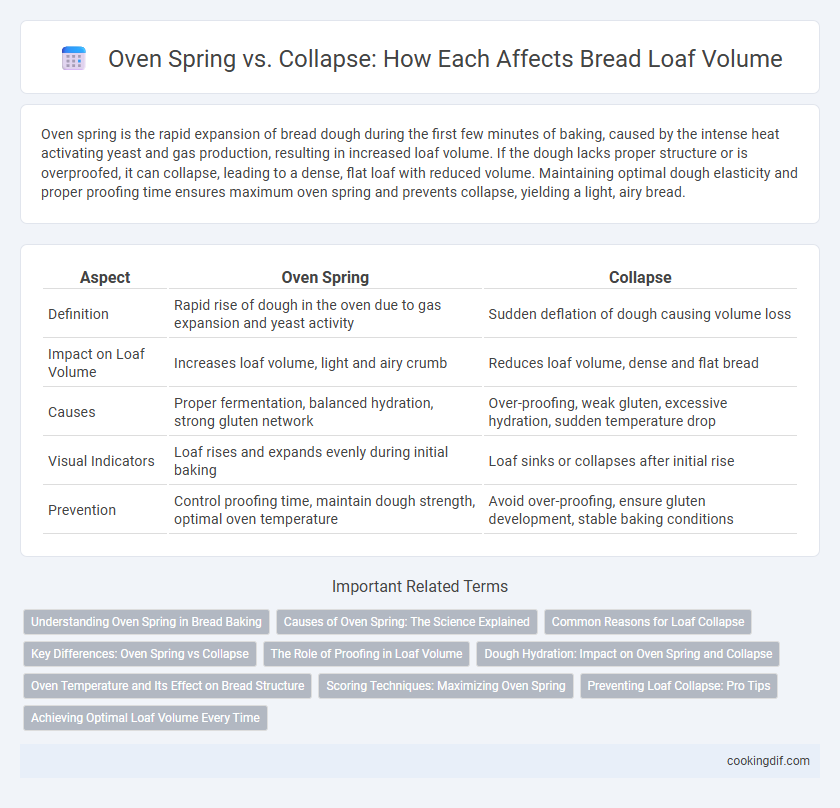Oven spring is the rapid expansion of bread dough during the first few minutes of baking, caused by the intense heat activating yeast and gas production, resulting in increased loaf volume. If the dough lacks proper structure or is overproofed, it can collapse, leading to a dense, flat loaf with reduced volume. Maintaining optimal dough elasticity and proper proofing time ensures maximum oven spring and prevents collapse, yielding a light, airy bread.
Table of Comparison
| Aspect | Oven Spring | Collapse |
|---|---|---|
| Definition | Rapid rise of dough in the oven due to gas expansion and yeast activity | Sudden deflation of dough causing volume loss |
| Impact on Loaf Volume | Increases loaf volume, light and airy crumb | Reduces loaf volume, dense and flat bread |
| Causes | Proper fermentation, balanced hydration, strong gluten network | Over-proofing, weak gluten, excessive hydration, sudden temperature drop |
| Visual Indicators | Loaf rises and expands evenly during initial baking | Loaf sinks or collapses after initial rise |
| Prevention | Control proofing time, maintain dough strength, optimal oven temperature | Avoid over-proofing, ensure gluten development, stable baking conditions |
Understanding Oven Spring in Bread Baking
Oven spring is the rapid rise of bread dough during the first few minutes of baking caused by the expansion of gases and increased yeast activity before heat kills the yeast. Achieving optimal oven spring enhances loaf volume by allowing maximum gas retention within the dough's gluten structure. Poor oven spring often leads to collapse, resulting from weak gluten development, excess dough hydration, or insufficient oven temperature, which compromises the final bread texture and shape.
Causes of Oven Spring: The Science Explained
Oven spring occurs due to the rapid expansion of gases within the dough when exposed to high oven temperatures, causing the loaf to rise significantly. Yeast activity and trapped carbon dioxide contribute to this expansion until heat inactivates the yeast, while gluten structure provides the necessary strength to hold the loaf's shape. Insufficient gluten development or excessive proofing leads to collapse, as the dough cannot withstand the internal pressure during the oven spring phase.
Common Reasons for Loaf Collapse
Loaf collapse often results from underproofing, where insufficient gas production causes inadequate crumb structure, or overproofing, which weakens gluten strands and traps too much gas, leading to deflation during baking. High oven temperature shock and improper scoring can also disrupt oven spring by causing uneven expansion and steam release, reducing final loaf volume. Poor dough hydration and weak flour protein content fail to support gas retention, making the loaf prone to collapse after initial rise.
Key Differences: Oven Spring vs Collapse
Oven spring refers to the rapid expansion of bread dough during the first few minutes of baking, caused by the heat activating yeast and steam, which significantly increases loaf volume. Collapse occurs when the structure of the dough is too weak to support the gas produced during baking, leading to a deflated or sunken loaf with reduced volume. Key differences include the presence of strong gluten development and proper proofing in oven spring, whereas collapse often results from overproofing, insufficient gluten strength, or excessive moisture.
The Role of Proofing in Loaf Volume
Proper proofing time directly impacts oven spring by allowing yeast to produce carbon dioxide, which creates gas bubbles that expand during baking, increasing loaf volume. Underproofed dough results in limited gas development, causing minimal oven spring and a denser crumb, while overproofed dough weakens gluten structure, leading to collapse and reduced volume. Achieving optimal proofing balances gas retention and gluten strength, ensuring maximum oven spring and a well-risen loaf.
Dough Hydration: Impact on Oven Spring and Collapse
Dough hydration significantly influences oven spring and loaf volume, as higher hydration levels increase gas retention, resulting in improved oven spring and a lighter crumb structure. Excessive hydration, however, weakens the gluten network, making the dough prone to collapse during baking, which reduces overall loaf height and density. Optimal hydration balances moisture and gluten strength, maximizing oven spring while preventing structural failure and collapse.
Oven Temperature and Its Effect on Bread Structure
Oven temperature plays a critical role in oven spring, directly impacting loaf volume by rapidly expanding gases and activating yeast before starch gelatinization firms the crumb structure. High oven temperatures promote a strong oven spring, resulting in a lighter, airier crumb, while lower temperatures risk insufficient gas expansion and early collapse, producing a denser loaf. Precise temperature control ensures proper crust formation, which stabilizes the bread's structure, preventing collapse during baking.
Scoring Techniques: Maximizing Oven Spring
Scoring techniques play a crucial role in maximizing oven spring by controlling the expansion of gases during baking, which directly impacts loaf volume. Properly scored dough allows steam to escape in a controlled manner, preventing collapse and promoting an even rise. Strategic cuts along the surface guide loaf expansion, resulting in a better crumb structure and enhanced overall volume.
Preventing Loaf Collapse: Pro Tips
To prevent loaf collapse and maximize oven spring, maintain proper dough hydration levels between 60-65% to ensure optimal gluten structure. Use strong bread flour with a protein content of 11-14% to provide sufficient elasticity and gas retention during baking. Avoid over-proofing by monitoring dough rise closely, aiming for a 75-100% volume increase before baking to sustain internal gas pressure and achieve maximum loaf volume.
Achieving Optimal Loaf Volume Every Time
Oven spring is the rapid rise of bread dough during the first few minutes of baking, caused by the expansion of gas bubbles and yeast activity, which significantly increases loaf volume. Collapse occurs when the dough structure weakens due to over-proofing or insufficient gluten development, resulting in a dense, flat loaf. Achieving optimal loaf volume requires balancing proper fermentation time, strong gluten networks, and correct oven temperature to ensure maximum oven spring without collapse.
Oven spring vs collapse for loaf volume Infographic

 cookingdif.com
cookingdif.com